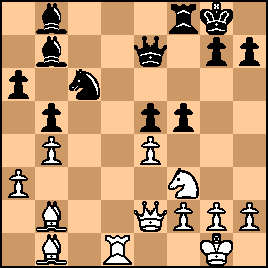KEG: Post II
17... f5?!
Rightly condemned in the Tournament Book, which rightly suggests 17...RxR after which White's edge, if any would be minuscule. As stated in the Tournament Book, the text seriously weakens Black's pawn structure. It was, however, part of Horowitz' flawed idea which would soon become clear. 18. Bb1 RxR
19. RxR

click for larger viewBlack's weakened pawns are an eyesore, but he might nonetheless have been able to hold the position with 19...Rd8 or maybe 19...h6. But now Horowitz' plan was revealed. 19... e5?!
Though not questioned by the Tournament Book, the text was a bad mistake. Perhaps Horowitz missed the simple refutation. Kashdan most definitely saw it: 20. e4!

click for larger view"!"--(Tournament Book).
"Preventing 20...e4, and leaving the Black e-pawn backward and exposed to attack." (Tournament Book) Horowitz here probably had nothing better than 20...f4 21. Ba2+ Kh8 22. Bd5 as given in the Tournament Book. Horowitz would even then have had his hands full to try to hold the game. We have no way of knowing if Horowitz' next move was part of his plan. In any case, it was awful: 20... Nd4?
This loses a pawn and leaves Black little chance to recover. As will be evident presently, however, Horowitz had one more bad plan up his sleeve. [It pains me to report all this. When I started playing chess, Horowitz's books were among my early companions. His play in this game, however, leaves no hint of his fine talent. He DID, after all, defeat the mighty Reshevsky in the next round]. 21. NxN exN
22. Bxd4

click for larger view22... Bxe4?
Did Horowitz just miss the fact that this loses the exchange instantly? Did he have some deeper idea in mind? In any case, the text was a disaster: 23. Bc5

click for larger viewOuch!
Horowitz now tried a desperate trick. But Kashdan was not to be caught napping: 23... Qe5
If 23...Qc7 (probably Black's "best"), 24. Bd6 is decisive. If instead 23...Qh4, White wins easily after 24. g3 Qh3 25. BxB. 24. f4
The most accurate way to end Black's resistance. 24... Qxf4
25. g3 Qf3
"A last attempt, which costs a piece, however." (Tournament Book) 
click for larger view26. QxQ BxQ
27. Ba2+
He could also just have played 27. Rf1 immediately. 27... Kh8
28. Rf1

click for larger view1-0
A terrible debacle for Horowitz.
As for Kashdan, he did what he had to. | 




